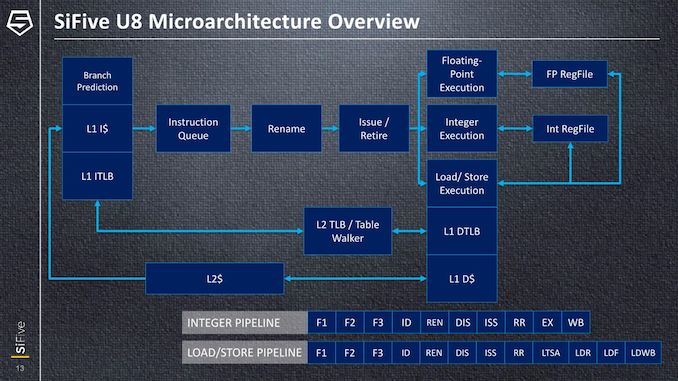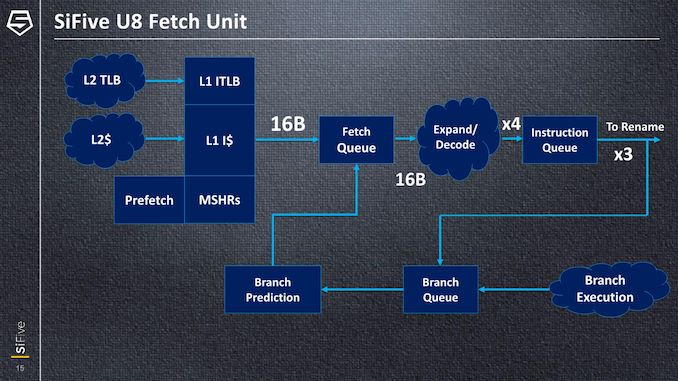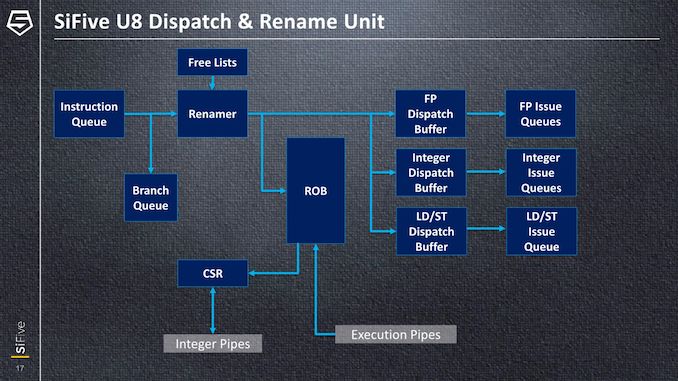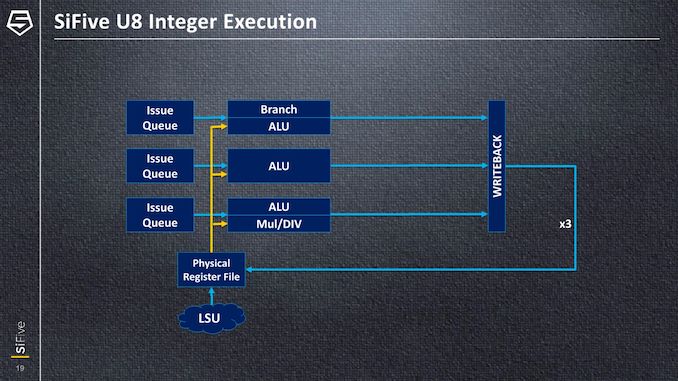SiFive Announces First RISC-V OoO CPU Core: The U8-Series Processor IP
by Andrei Frumusanu on October 30, 2019 10:00 AM ESTThe U8-Series Microarchitecture
We’ve had the pleasure of being briefed on the key aspects of the U8 microarchitecture, and we’ll be able to have a more in-depth look (albeit high-level) at how the new CPU design functions.
At the highest level, the U8 is a 3-wide issue out-of-order CPU with a pipeline depth of 12 stages, feeding 3 execution units. It’s a pretty traditional OoO-design and the noteworthy design choice here is the core’s use of physical register files instead of an architectural one, such as seen in initial Arm designs such as the A72.
One thing to note as we’re covering the microarchitecture is that SiFive didn’t disclose the exact sizes of some of the structures, which is somewhat natural given the core’s purported scalable configuration design where one can change many aspects of the IP, and we’re only covering the generic U8-Series microarchitecture as individual implementations (Such as an U84) will have different configurations.
The fetch unit of the core is able to request instructions out of the L1I at 16 bytes per cycle and put it into the fetch queue of the front-end. The RISC-V ISA has a variable instruction encoding size, so it’s not possible to map this to an exact number on instructions as one can on the Arm ISA, but if we naively assume a 32-bit average, it would correspond to 4 instructions per cycle. Of course, this isn’t surprising as the decoder on the U8 is 4-wide, feeding expanded instructions into the instruction queue.
The interesting thing here about the core is that the instruction queue is only able to issue 3 instructions out to the rename stage. Having the fetch width being higher than your issuing rate helps in the case of branch mispredictions and bubbles and allows the front-end to catch up with the execution backend, something we’ve also seen in other cores; however, we never quite saw an implementation in which the decoder was wider than the issue rate (Actually, only Intel's recent Tremont microarchitecture would also fit this characteristic). Beyond it being a deliberate design decision for the balance of the microarchitecture, maybe it’s also a forward-looking implementation on the part of the decoder whilst we may see wider issue configurations in future U8 designs.
Moving on to the mid-core, we see a traditional design into the rename stage, a re-order buffer and three dispatch engines feeding into the execution pipelines. The diagram here is a bit misleading in terms of the arrows going into the issue queues – it doesn’t mean that it’s only one instruction per issue queue, the core can still dispatch up to 3 instructions into the integer issue queues for example.
It would have been interesting to hear about the exact structure sizes on this part of the core but SiFive didn’t cover these details during the presentation.
On the integer execution block, we see that it’s actually composed of three execution pipelines. Each has its own issue queue, feeding into three ALU pipelines with different capabilities. One pipeline serves just as a regular ALU, a second one shares the port with the branch unit, while the third pipeline is a more complex one capable of integer multiplication and division.
Unfortunately, SiFive didn’t go into any detail of the floating-point pipelines or the L/S units. On the FP side, things should be relatively simple in terms of the execution capabilities, at least on the U84 core. Currently, RISC-V does not have any SIMD/Vector instructions as that ISA extension has not been finalized yet. SiFive explains that this might happen at the end of the year, and the U87 is poised to adopt the new vector capabilities next year.














68 Comments
View All Comments
Wilco1 - Thursday, October 31, 2019 - link
There is no such requirement in RISC. SIMD is big and complicated of course but so is floating point and it naturally fits with the floating point pipeline.Lbibass - Tuesday, November 5, 2019 - link
I mean, look at intel! They've been stuck at 14nm for the past half-decade. And this company can fix their issues quite quickly. They're much more nimble.digitalgriffin - Wednesday, November 6, 2019 - link
Yes because Arduino, ESP8x and RaspPi, all need SIMD and Vect ops. (Bit of sarcasm there) These devices sell in the millions mostly as IOT Edge or embedded control devices.FunBunny2 - Wednesday, October 30, 2019 - link
One of the Intel CxOs, back around the release of the 8086, allowed as how he'd rather have the chip in every Ford than in every PC. Not likely anyone would say so today, but the use of embedded cpu is where this all started, not PC cpu.What matters, if anyone can do it, is an analysis of dissimilar ISA, ARM v. RISC-V for example, without regard to implementation, e.g. cache size and other 'stretchable' components that depend on engineering of silicon (area, mostly), not abstract architecture. As many have said over the years, RISC machines (real world) have incrementally included CISC instructions.
name99 - Wednesday, October 30, 2019 - link
It's SiFive's first OoO core, not the first RISC-V OoO core.BOOM (Berkeley Out of Order Machine) is from around 2016
https://github.com/riscv-boom/riscv-boom
levizx - Wednesday, October 30, 2019 - link
2.3X IPC * 1.4X F = 3.22X PERFand since 2.3, 1.4 are "higher" while 3.1 is "total", it actually should be
3.3*2.4=7.92X performance >> 3.1X
Something isn't right.
The_Assimilator - Wednesday, October 30, 2019 - link
It's marketing to secure more funding because the company doesn't actually have any real silicon to show, what do you expect?surt - Saturday, November 2, 2019 - link
The 2.3x IPC part is ideal, the processor isn't magically going to never stall etc. If they can actually get as close as 3.1/3.22 that's very good. And yes the wording makes you want to add one but they clearly didn't mean that.EugeneBelford - Wednesday, October 30, 2019 - link
Kate Libby: RISC is goodSamus - Friday, November 1, 2019 - link
Hackers predicted so much yet nothing at all :)